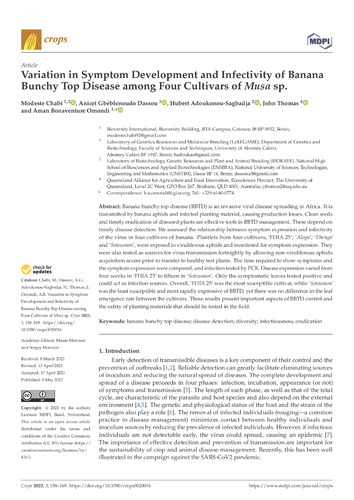Variation in symptom development and infectivity of Banana Bunchy Top Disease among four cultivars of Musa sp.
Banana bunchy top disease (BBTD) is an invasive viral disease spreading in Africa. It is transmitted by banana aphids and infected planting material, causing production losses. Clean seeds and timely eradication of diseased plants are effective tools in BBTD management. These depend on timely disease detection. We assessed the relationship between symptom expression and infectivity of the virus in four cultivars of banana. Plantlets from four cultivars, ‘FHIA 25’; ‘Aloga’; ‘Ebenga’ and ‘Sotoumon’, were exposed to viruliferous aphids and monitored for symptom expression. They were also tested as sources for virus transmission fortnightly by allowing non-viruliferous aphids acquisition access prior to transfer to healthy test plants. The time required to show symptoms and the symptom expression were compared, and infection tested by PCR. Disease expression varied from four weeks in ‘FHIA 25’ to fifteen in ‘Sotoumon’. Only the symptomatic leaves tested positive and could act as infection sources. Overall, ‘FHIA 25’ was the most susceptible cultivar, while ‘Sotoumon’ was the least susceptible and most rapidly expressive of BBTD, yet there was no difference in the leaf emergence rate between the cultivars. These results present important aspects of BBTD control and the safety of planting materials that should be tested in the field.

